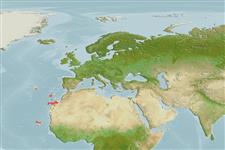Environment: milieu / climate zone / depth range / distribution range
Ekologi
laut dasar (demersal); kisaran kedalaman 1 - 200 m (Ref. 27000), usually 20 - 30 m. Subtropical; 39°N - 12°N, 27°W - 12°W (Ref. 5222)
Eastern Atlantic: known with certainty only from the Azores, Madeira, Cape Verde, and the Canary Islands.
Size / Weight / umur
Maturity: Lm ? range ? - ? cm
Max length : 80.0 cm TL jantan/; (Ref. 5222); Berat maksimum terpublikasi: 3.0 kg (Ref. 5222)
Duri punggung (Keseluruhan (total)): 11; duri punggung lunak (Keseluruhan (total)): 14-16; Duri dubur 3; Sirip dubur lunak: 10 - 12. Distinguished by the following characteristics: brownish or dark grey body color of adults with irregular pale blotches and spots and prominent maxillary streak (capable of reversing body color pattern when under stress); juveniles mottled greenish brown, with prominent white spots on head and body, median fins with white streaks and hyaline golden pectoral fins; oblong and compressed body, depth 3.0-3.3 times in SL; head length 2.6-2.9 times in SL; convex interorbital area; enlarged serrae of preopercle at the angle, forming rounded lobe below shallow indentation on vertical limb; few small serrae on subopercle and interopercle; subequal sizes of anterior and posterior nostrils in juveniles, adults with 3 times larger posterior nostrils compared to anterior ones; lower jaws extends well in front of upper jaw (Ref. 89707).
Adults occur near the bottom in rocky areas; juveniles are found in tide pools (Ref. 89707). Two specimens collected from the Cape Verde by J. Cadenat were from a depth of '50' m (Ref. 27000). Observed to have a homing behaviour leaving the bay of Garajau on the south coast of Madeira Island in spring and returning every year in autumn (Ref. 75147).
Life cycle and mating behavior
Kematangan | Reproduksi, perkembang biakan | Pemijahan | telur-telur | Fecundity | Larva
Heemstra, P.C. and J.E. Randall, 1993. FAO Species Catalogue. Vol. 16. Groupers of the world (family Serranidae, subfamily Epinephelinae). An annotated and illustrated catalogue of the grouper, rockcod, hind, coral grouper and lyretail species known to date. Rome: FAO. FAO Fish. Synop. 125(16):382 p. (Ref. 5222)
Status IUCN Red List (Ref. 130435)
ancaman kepada manusia
Harmless
penggunaan manusia
Perikanan: komersial
informasi lanjut
Nama-nama umumSinonim (persamaan)metabolismePemangsaEkotoksikologiReproduksi, perkembang biakanKematanganPemijahanSpawning aggregationFecunditytelur-telurpekembangan telor
AcuanBudidaya airprofil budidaya airStrainGenetikaElectrophoresesDiturunkanPenyakit-penyakitPengolahanNutrientsMass conversion
mitraGambarStamps, Coins Misc.Suara-suaraCiguateraKecepatanTipe renangArea insangOtolithsOtakPenglihatan / visi
Alat, peralatan
laporan khas
muat turun XML
Sumber internet
Estimates based on models
Preferred temperature (Ref.
123201): 16.7 - 25.3, mean 19.9 °C (based on 56 cells).
Phylogenetic diversity index (Ref.
82804): PD
50 = 0.5000 [Uniqueness, from 0.5 = low to 2.0 = high].
Bayesian length-weight: a=0.00933 (0.00429 - 0.02028), b=3.04 (2.87 - 3.21), in cm total length, based on LWR estimates for this Genus-body shape (Ref.
93245).
Trophic level (Ref.
69278): 4.3 ±0.8 se; based on size and trophs of closest relatives
Daya lenting (Ref.
120179): Rendah, Waktu penggandaan populasi minimum 4.5 - 14 tahun (Preliminary K or Fecundity.).
Fishing Vulnerability (Ref.
59153): Moderate to high vulnerability (52 of 100).
Nutrients (Ref.
124155): Calcium = 48.1 [19.8, 93.7] mg/100g; Iron = 0.889 [0.481, 1.676] mg/100g; Protein = 18.5 [16.6, 20.2] %; Omega3 = 0.377 [0.243, 0.607] g/100g; Selenium = 33.8 [17.2, 66.8] μg/100g; VitaminA = 20 [6, 74] μg/100g; Zinc = 0.519 [0.366, 0.765] mg/100g (wet weight);
